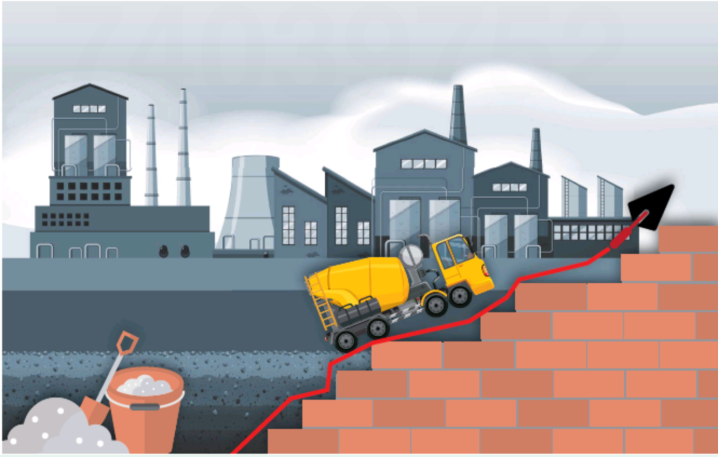CEMENT INDUSTRY
South Africa’s protectionist policy aimed at setting the foundations for a sector recovery

Cement companies are hoping for higher sales volumes and profits after the government implemented a protectionist policy that aims to shield the industry from cheap cement imports.
Could the National Treasury’s decision to ban the use of imported cement for all government-funded infrastructure projects finally provide a happy ending for SA’s beleaguered cement industry?
The Treasury’s protectionist policy has been hailed as a big win for the local cement industry, which has been battling for survival since 2014 – a period in which cheap cement imports repeatedly flooded the SA market and ate into the profits of local producers.
“Cheap cement imports from Pakistan, China, and Vietnam were already killing SA’s cement industry. Then the Covid-19 lockdowns arrived, which stopped construction projects. This was the final nail in the coffin for the industry,” Bryan Perrie, the CEO of industry body Cement and Concrete SA, told DM168. “There’s finally light at the end of the tunnel with the Treasury’s move.”
A Treasury circular in early October notified all relevant state departments that, in terms of its preferential procurement regulations, no imported cement can be used on infrastructure projects funded by the government as of 4 November.
The circular also prescribes that all state organs, including state-owned enterprises, must stipulate in their tender invitations that only SA-produced cement, produced with locally sourced raw materials, will be allowed for use on public-sector construction projects.
Over the next decade, the government plans to mobilise R1.1-trillion in funding from the Treasury, state-owned enterprises, development finance institutions, pension funds and commercial banks for infrastructure projects to grow the economy, create jobs and stimulate private sector investment. So far, eight sets of infrastructure projects – spanning water, roads, housing and student accommodation – are in the pipeline. They will require R105-billion to implement.
Infrastructure projects of this magnitude have not been seen since the 2010 Fifa World Cup, which unleashed infrastructure investment in soccer stadiums and a high-speed train.
The government has neglected the maintenance of municipal infrastructure, the budget for which was cut by the Treasury to redirect money to fund fee-free higher education and to offset low revenue collection. Treasury figures show that the budget for municipal infrastructure, housing and school buildings was cut by R100-million in the 2014/15 fiscal year, R46.6-billion in 2016/17, and R48.3-billion in 2018/19.
A boon for cement makers
The government plans to ramp up infrastructure investments, and local cement makers want to be preferred suppliers for these projects, which could turn their fortunes around.
Even investor sentiment on the JSE about basket-case cement makers such as PPC and Sephaku has turned positive after the Treasury’s circular.
The share price of PPC, once a blue-chip darling of the JSE, increased by more than 20% this week, adding R2.1-billion to its market value. The Public Investment Corporation took notice of the share price rally and increased its stake in PPC to 5.37%. Sephaku, a smaller cement player, also saw its share price leap by more than 40%, adding R160-million to its market value.
Sephaku said the Treasury directive will help it take advantage of the government’s planned infrastructure projects. Sephaku’s subsidiary, Métier Mixed Concrete, has cement factories in Gauteng, Mpumalanga and the Western Cape, which will help it “to compete for the supply of concrete into the strategic infrastructure projects”.
Njombo Lekula, MD of PPC Southern Africa, said the Treasury’s move “is positive not only for PPC but also for the local economy”. It has the potential to save the local construction industry, create jobs and sustain economic growth.
PPC has already sought infrastructure projects to supply cement to, launching a roadshow this week in the Western Cape, where it started partnership talks with construction companies.
“In KwaZulu-Natal and the Western Cape, some of the national and provincial roads are currently being upgraded. The SA National Roads Agency is the first state-owned enterprise that has implemented infrastructure projects. We want to participate in these projects,” Lekula told DM168.
Imported cement can still be used in private sector construction, but not in the public sector. Lekula said PPC and other industry players are lobbying for the private sector to be deliberate about not using imported cement.
Over the past five years, PPC has reported cumulative financial losses of more than R1.3-billion. Sephaku reported losses of R36-million for the same period.
Other private companies, such as AfriSam, Lafarge SA and Natal Portland Cement, are probably in the same boat, but their financial results are not available for public consumption.
The financial losses are a direct result of cement sales volumes dropping because of fewer infrastructure projects, bad business decisions (especially PPC, whose rapid expansion in the rest of Africa, using debt, has been ill-fated) and cheap cement imports entering SA. The latter is a touchy matter for the industry.
Seeking import tariffs
Imports from Pakistan started to make their way into SA around 2007. By 2014, imports from Pakistan were peaking at 1.4-million tonnes a year.
Cement and Concrete SA’s Perrie said the biggest customer of imported cement is the “man on the street who builds their own house”.
“People will go for the cheaper option regardless of where it comes from. Factories are also buying the imported cement on price.”
The local industry has an annual cement production capacity of about 20 million tonnes, demand is languishing at 13 million tonnes, leaving an unused-cement capacity of about seven million tonnes. Add the one million tonnes of imported cement from Pakistan and spare capacity swells.
The industry approached the International Trade Administration Commission (Itac) to investigate allegations of cement dumping in SA by Pakistan. Itac found in 2014 that there was evidence of bagged cement dumping.
From May 2015, SA introduced import tariffs of 14.29% to 77.15% on cement from Pakistan. The tariffs were effective: cement imports dropped by 497,269 tonnes in 2016 and have fallen further in subsequent years.
But the Pakistan tariffs expire in December 2021. SA’s cement industry has approached Itac to extend the duration of these tariffs, or increase them. The cement industry also wants Itac to implement general import tariffs that are not country-specific but target notorious cement dumpers. China and Vietnam have usually stepped in to fill the gap left by Pakistan when the amount of its cement coming into SA drops.
In some cases, the governments of China and Vietnam have offered subsidies to cement companies – in contravention of World Trade Organization rules – to help them flood cement into places around the world.
PPC’s Lekula said: “We don’t want special treatment with the implementation of more tariffs. We want the playing field to be levelled.”
Locally produced cement is subject to additional regulatory requirements, including the carbon tax and requirements for companies to empower communities living around their production plants.
Local companies also face escalating energy costs and labour union pressures that add to production costs, as well as expensive quality checks of their cement undertaken by the South African Bureau of Standards. Importers don’t have to comply with local regulations or production costs. DM168
This story first appeared in our weekly Daily Maverick 168 newspaper which is available for R25 at Pick n Pay, Exclusive Books and airport bookstores. For your nearest stockist, please click here.





















 Become an Insider
Become an Insider
This will have an adverse impact on South Africa’s Nationally Determined Contributions to emission reductions because cement production is highly carbon intensive and manufacturing it locally will count against SA’s carbon footprint. Though globally where the cement is made will have little effect, at least until the rest of the world manages to change its cement processes.
Power consumption for cement manufacture is also considerable. This will add to Eskom demand, reducing the reliability of supply further. Factories may produce own power, but not 100% so.